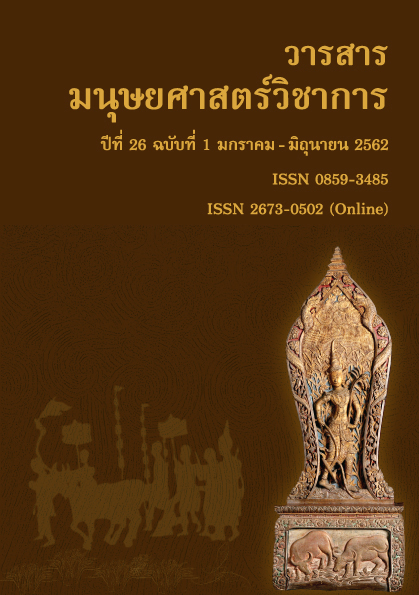The Acquisition of the Auxiliary Verb [tekuru] by Thai Learners of Japanese at Different Proficiency Levels
Main Article Content
Abstract
This research focused on the acquisition of the auxiliary verb tekuru by Thai Japanese as a foreign language (JFL) learners. The data used were transcriptions of interviews of 60 Thai learners conducted in the Oral Proficiency Interview (OPI). The oral proficiency levels were defined by the guidelines by the American Council on the Teaching of Foreign Languages (ACTFL). The result showed that [tekuru] was at first used in the intermediate level, and not in the novice level although it was commonly introduced at the novice level. The process of acquisition developed according to the “U-shaped learning curve” covering three stages of learning. The first stage (Lower Intermediate/Mid-Intermediate learners) began with a high rate of accuracy. The rate declined to a lower level in the second stage (Upper Intermediate/Lower Advanced learners), where various types of errors were found. The accuracy rate once again ascended to a higher level and the errors gradually faded in the third stage (Mid Advanced/Upper Advanced learners). The findings of the study provide information about appropriate order of lessons depending on the usage, types of errors, and different proficiency levels. The study also suggests that attention should be paid to the “non-use” errors, which were the ones most commonly encountered at every stage.
Keywords: tekuru; Thai learners of Japanese
Article Details
References
กนกวรรณ เลาหบูรณะกิจ คะตะกิริ, พัชราพร แก้วกฤษฎางค์, สมเกียรติ เชวงกิจวณิช และสุณีย์รัตน์ เนียรเจริญสุข. (2550). การกำหนดหัวข้อไวยากรณ์ชั้นต้นสาหรับผู้เรียนชาวไทย: แนวคิดสี่ประการจากมุมมองของไวยากรณ์เพื่อการสื่อสาร.วารสารเจแปนฟาวน์เดชั่นกรุงเทพฯ, 4, 67-78.
Corder, S. P. (1967). The Significance of Learners' Errors. International Review of Applied Linguistics in Language Teaching, 5, 161-170.
Ellis, R. (1994). The Study of Second Language Acquisition. Oxford: Oxford University Press.
Himeno Tomoko. (2009). Nihongo Washa wa “Mie” no Mama ni Hanasu. In Ikegami Toshihiko & Moriya Michiyo (Eds.), Shizen na Nihongo o Oshieru Tameni: Ninchi Gengogaku o Fumaete (pp. 60-123). Tokyo: Hitsuji Shobou. (in Japanese)
Izumi Shinichi. (2016). Dai 2 Gengo Shuutoku to Bogo Shuutoku kara “Kotoba no Manabi. o Kangaeru. Tokyo: ALC Press INC. (in Japanese)
Moriya Michiyo. (2009). Nihongo Kyouiku no Ba ni Arawareta Ninchi Gengogaku no Sekai. In Ikegami Toshihiko & Moriya Michiyo (Eds.), Shizen na Nihongo o Oshieru Tameni: Ninchi Gengogaku o Fumaete (pp. 52-59). Tokyo: Hitsuji Shobou. (in Japanese)
Morita Yoshiyuki. (1968). “IKU・KURU” no Youhou. Studies in the Japanese Language, 75, 75-86. (in Japanese)
Nakahama Yuko. (2016). Kinoushugiteki Approach ni Motozuku Daini Gengo Shuutoku Kenkyuu. Acquisition of Japanese as a Second Language, 19, 61-81. (in Japanese)
Ozeki Hiromi. (2010). Nihongo o Oshieru Tame no Daini Gengo Shuutokuron Nyuumon. Tokyo: Kuroshio Publishers. (in Japanese)
Pica, T. (1984). Methods of Morpheme Quantification: Their Effect on the Interpretation of Second Language Data. Studies in Second Language Acquisition, 6, 69-78.
Sakoda Kumiko. (2016). Corpus o Riyoushita Daini Gengo Shuutoku Kenkyuu no Kanousei to Kadai: Tagengo Bogo no Nihongo Gakushuusha Oudan Corpus(I-JAS) no Kouchiku ni Mukete. Acquisition of Japanese as a Second Language, 19, 5-28. (in Japanese)
Sawada Jun. (2009). Idoudoushi “Kuru” no Bunpouka to Houkouzuke Kinou: “Basho Deixis” kara “Shinriteki Deixis” e. Studies in Pragmatics, 11, 1-20. (in Japanese)
Shirakawa Hiroyuki. (2007). Gakushuusha no Goyou・Hiyou o Dou Kangaeru ka. Bulletin of the Graduate School of Education, Hiroshima University Part II, Arts and Science Education, 56, 173-179. (in Japanese)
Slobin, Dan I. (1991). Learning to Think for Speaking: Native Language, Cognition, and Rhetorical Style. Pragmatics, 1(1), 7-25.
Sugaya Natsue. (2002). Nihongo Gakushuusha Niyoru IKU・KURU, TEIKU・TEKURU no Shuutoku Kenkyuu: Prototype Riron no Kanten kara. Japanese Language Education, 23, 66-79. (in Japanese)
Uchiyama Jun. (2011). Hojodoushi “Tekuru” “Teiku” no Aspect Nitsuite. Kinjo Gakuin Daigaku Ronshuu Jinbunkagakuhen, 7(2), 1-13. (in Japanese)
Yamamoto Yuko. (2007). “Shukansei” no Shihyou Toshite no “-TEIKU” “-TEKURU”. Journal of the College of Humanities, Chubu University, 17, 67-81. (in Japanese)
Yamauchi Hiroyuki. (2009). Proficiency kara Mita Nihongo Kyouiku Bunpou. Tokyo: Hitsuji Shobou. (in Japanese)
Yoshikawa Taketoki. (1976). Gendai Nihongo Doushi no Aspect no Kenkyuu. In Kindaichi Haruhiko (Ed.), Nihongo Doushi no Aspect (pp. 155-327). Tokyo: Mugi Shobou. (in Japanese)


